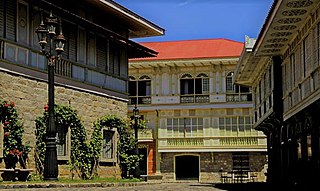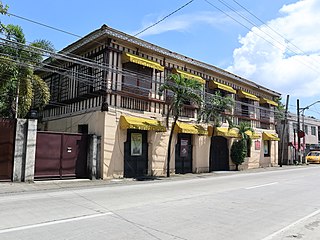
Glan, officially the Municipality of Glan, is a 1st class municipality in the province of Sarangani, Philippines. According to the 2020 census, it has a population of 109,547 people.

Silay, officially the City of Silay, is a 3rd class component city in the province of Negros Occidental, Philippines. According to the 2020 census, it has a population of 130,478 people.

DonMariano Jesús Cuenco y Diosómito was a Filipino politician and writer from Cebu. He was the 4th President of the Senate of the Philippines.

The architecture of the Philippines reflects the historical and cultural traditions in the country. Most prominent historic structures in the archipelago are influenced by Austronesian and American architectures.

Carcar, officially the City of Carcar, is a 5th class component city in the province of Cebu, Philippines. According to the 2020 census, it has a population of 136,453 people.

The Mariano Ramos Ancestral House is the home of the late Mariano Ramos, one of the first appointed Presidente Municipals of Bacolod, Philippines. The house was built in the 1930s with its architecture being a combination of Castilian and Tuscan styles. It comprises three storeys including the tower room, known as the torre or mirador.

The Balay Negrense, also known as Victor Fernandez Gaston Ancestral House, is a museum in Silay City, Negros Occidental in the Philippines, showcasing the lifestyle of a late 19th-century Negrense sugar baron. It is notable for being the first museum to be established in the province of Negros Occidental.

Ancestral houses of the Philippines or Heritage Houses are homes owned and preserved by the same family for several generations as part of the Filipino family culture. It corresponds to long tradition by Filipino people of giving reverence for ancestors and elders. Houses could be a simple house to a mansion. The most common ones are the "Bahay na Bato". Some houses of prominent families had become points of interest or museums in their community because of its cultural, architectural or historical significance. These houses that are deemed of significant importance to the Filipino culture are declared Heritage House by the National Historical Commission of the Philippines (NHCP), previously known as the National Historical Institute (NHI) of the Philippines. Preservation is of utmost importance as some ancestral houses have come into danger due to business people who buy old houses in the provinces, dismantle them then sell the parts as ancestral building materials for homeowners wishing to have the ancestral ambiance on their houses. These ancestral houses provide the current generation a look back of the country's colonial past through these old houses.

The National Historical Commission of the Philippines (NHCP) and its predecessor agencies in the Philippines and abroad installs historical markers to signify important and historic events, persons, structures, and institutions. The commemorative plaques are permanent signs installed by the NHCP in publicly visible locations on buildings, monuments, or in special locations. The NHCP also allows local municipalities and cities to install markers of figures and events of local significance, although these markers are barred from using the seal of the Republic of the Philippines.

Don Catalino Rodriguez Ancestral House, also known as Villa Sariaya, is one of the three houses declared by the National Historical Institute of the Philippines as Heritage house in Sariaya, Quezon. It was owned by Don Catalino Rodriguez, Sariaya’s town Presidente from 1908 to 1909. The house occupies an entire block near the church park. Its main entrance faces south along Calle Daliz and is bounded by Calle Rizal on the west and Quezon Avenue on the east. This house has already been transformed into a Museum and visitors can choose to wear period costumes for reasonable fees and pose for souvenir photos. Don Catalino Rodriguez Ancestral House is listed as one of the Ancestral Houses in the Philippines, under Region IV-A.

The Archdiocesan Shrine of Patrocinio de Maria Santisima, commonly known as Boljoon Church, is a Roman Catholic church dedicated to Our Lady of the Patronage in the municipality of Boljoon, Cebu, Philippines, under the Archdiocese of Cebu.

The Lacson Ruins are the remains of the ancestral mansion of Don Mariano Ledesma Lacson and Maria Braga Lacson. It is situated in Talisay, Negros Occidental, Philippines. The mansion was built in early 1900s and inspired by Italian architecture.

Vicente Rama was a Filipino Visayan legislator, publisher, and writer from Cebu, Philippines. Recognized as the Father of Cebu City, he authored the bill for its cityhood which was approved into law by October 20, 1936. He also founded the leading pre-war Cebuano periodical, Bag-ong Kusog.
Maximino Jaen Noel was a Filipino politician and the longest-serving congressman from Cebu, Philippines. Representing Cebu's 3rd district, he was a member of the House of Representatives from 1928 to 1934, 1945 to 1949 and 1953 to 1965. He was a member of the National Assembly from 1938 to 1941.
Santiago Villagonzalo Lucero was a Filipino Visayan lawyer, politician and judge from Cebu, Philippines. He was mayor of the municipality of Ronda (1934–1936) and member of the House of Representatives for Cebu's 6th legislative district (1954–1956).
Philippines National Historic Landmarks is a registry of historic sites in the Philippines that have been officially declared by the Philippine Registry of Cultural Property.

The Alberto Mansion is a historic house in Biñan, Laguna, Philippines.

Camiña Balay Nga Bato, formerly known as Avanceña House, is a 159-year-old bahay na bato in the Arevalo district, Iloilo City, Philippines. It was built in 1865 and was designed by the first parish priest of Molo, Anselmo Avanceña, for Don Fernando Avanceña and his wife, Eulalia Abaja. It was then passed on from one family to another until it came under the Camiñas family.[1] It is now owned by the fourth generation of the original owners, Gerard Camiña, former director of the Land Transportation Office in Western Visayas, and his wife, Luth Camiña. The ancestral house was declared as an Important Cultural Property by the National Museum of the Philippines (NMP) in 2015.

The Mariano Hamoy House is an ancestral house in Dapitan, Zamboanga del Norte, Philippines. It now serves as a heritage museum, known as Balay Hamoy Museum, diplaying materials relevant to Rizal's exile in Dapitan from 1892 to 1896.


















